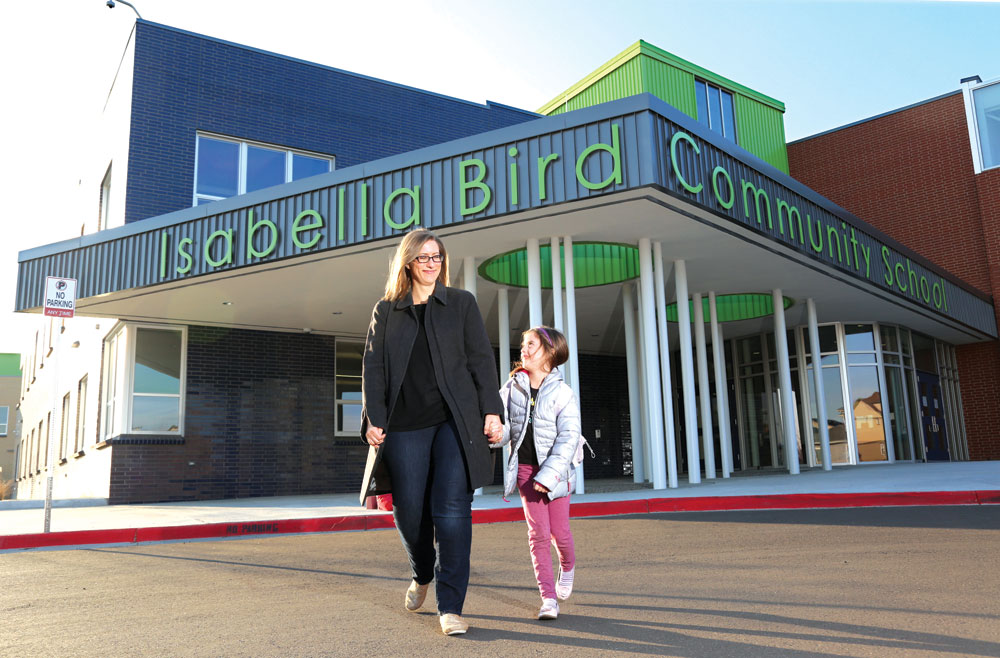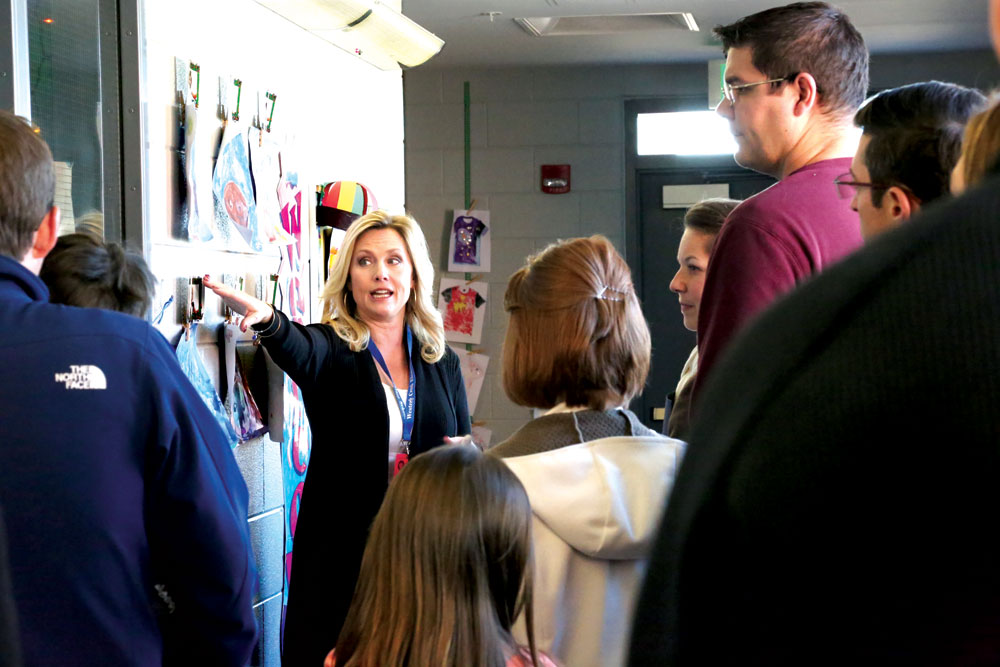
Kenda Keenan got her fifth choice, Isabella Bird Community School, for her daughter Evan, 6, but now she’s thrilled with the school. “I went from feeling really cheated to feeling like I had won the lottery.”
“Stressful.”
“Terribly unnerving.”
“Very challenging.”
“I was totally panicked.”
DPS choice forms must be submitted by Jan. 30 and many won’t know the outcome until March. As thousands of parents await the results of this year’s school choice lottery, those who have been through the process before say they found the experience laced with stress and anxiety, regardless of the outcome.
“I was so happy when it was over with,” said Gretchen Pilcher, mother of a sixth-grader at the newly opened Denver Discovery School.
“Home” School Means One of Five
In general, Denver Public Schools is based on a neighborhood-centric model. Families have the option of “choicing” elsewhere in the district, but are guaranteed a spot in one local school. In Stapleton and Park Hill, however, the process is very different. Children living in the Stapleton elementary school enrollment zone are guaranteed a seat in one of the five Stapleton elementary schools, but the “choice” process determines whether they get their preferred option among those schools. Similarly, within the Stapleton-Park Hill shared middle school boundary, the guarantee is for a seat in one of the five local middle schools, not in a specific school.
“I’m not wild about it,” one local father said, asking not to be identified for fear of upsetting friends and neighbors. “I wish there was a neighborhood option.”
That father appears to be in the minority, however. A 2013 Stapleton United Neighbors survey of approximately 2,000 residents indicated that, in spite of the anxiety produced by school choice, nearly 70 percent of respondents prefer some variation of an open enrollment system.
“We like that there is a school choice process,” Steven and Jenn Arzberger said, adding that the choice process allowed them to match the strengths of their child to the strengths of a school.
Why Enrollment Zones Rather Than Neighborhood Schools?
Whether they love or hate the system, many residents don’t know how or why the unique Stapleton Elementary Enrollment Zone came about. The reasons lie in the history and unusual dynamism of this barely decade-old neighborhood.
Brian Eschbacher, DPS’s director of policy, planning and analysis, explained in an email that the “zone” was originally created because Stapleton’s first two schools, Bill Roberts and Westerly Creek, “were located so close together, it was a challenge to divide the boundaries up.” Later, even as additional schools were built, the system helped DPS adapt to rapid changes in the size, location and demographics of Stapleton’s population as one neighborhood after another filled in.
Asked if DPS would consider “hard boundaries” in the future, Eschbacher said that would be “impractical” because of “high growth, particularly north of I-70.” The boundaries, he explained, “would in essence have to be continually be redrawn each time a new neighborhood opens or a new school opens, which is very disruptive.”
In addition, the open enrollment zone allows the district to manage the demographic instability of an urban infill development, where the age diversity of residents skews initially toward a huge number of families with young children. In older parts of Stapleton, yields of kindergarteners have shifted over time, decreasing as much as 25 percent from 2009 to 2013, just as newer neighborhoods in the area have seen increasing numbers of kindergarteners. The open enrollment zone allows the district to shift capacity among the schools, controlling class sizes. In a closed boundary, one Stapleton school could end up with a kindergarten class size of 18 kids per class while another school might have 35 kindergarteners per class.
Eschbacher added that the current, zone-based system “gives families in the neighborhood access to five high-performing options.”
“Take a Deep Breath,” The Lottery Can Be Stressful
Even with good justifications for the choice zone, the wait for the lottery results can be agonizing. District-wide, about 80 percent of kindergarteners will get their first choice for elementary school, Eschbacher noted. That means, of course, that 20 percent of kindergarteners do not get their first choice.
When Kenda Keenan went through the choice process, she received her fifth choice, “Eastbridge 4,” a school so new that it didn’t have a name or location at the time of the choice lottery.
“My experience with school choice was pretty emotional. I remember feeling the weight of needing to pick the ‘best’ one for my child,” Keenan said. “Imagine my surprise when I opened our letter and found that my daughter had been assigned to our fifth choice, a school that did not exist yet.”
Keenan said that she went to community meetings with the principal and staff of the school, learning what she could about the school that is now Isabella Bird Community School.
“To my great relief, I was thrilled,” she said. “I went from feeling really cheated to feeling like I had won the lottery.”
Other parents who did not receive their first choice in kindergarten decided to enter the choice lottery again in first grade.
“The choice process has been a very challenging process that has taken a significant amount of time and energy to understand and navigate,” Michelle Olsen said. Olsen’s daughter was placed in her second-choice school in kindergarten. Olsen decided to enter the choice lottery again in first grade, despite having a positive experience in kindergarten, primarily because she wanted her children to attend the school closest to their house.
The call that her daughter had been accepted into her top-choice school for first grade came four days before the beginning of school, Olsen said.
Olsen and Keenan both had the same advice for parents awaiting their school choice letters.
“Take a really deep breath,” Keenan said. “The process is as stressful as you let it be. All of the schools in Stapleton are wonderful schools.”
That’s a common refrain among parents. While school choice can be an emotionally challenging time for parents, the schools are all high quality.

Westerly Creek School tour
Future Capacity Crunch
The elementary open enrollment process demonstrates the challenge with the zone system; when there is more demand than capacity, fewer parents get their first choice school. In contrast, in the first year of the shared Park Hill-Stapleton middle school boundary, there was enough capacity at all of the schools that nearly every student got their first choice.
“Over 99 percent of zone students enrolled in their first choice school,” Eschbacher said.
The shared middle school boundary was established in the 2014-2015 school year to “increase access for students in the Greater Park Hill-Stapleton zone to high-performing middle school seats,” Eschbacher said.
McAuliffe International School moved into the Smiley building in Park Hill, replacing a struggling program there with a high-performing middle school that had rapidly outgrown its space at the overcrowded Swigert-McAuliffe building. The move allowed the district to increase middle school capacity in the area without constructing a new building, putting the Denver Discovery School in McAuliffe’s old space.
“DPS is pleased with the impact the solution has made so far. Previously, over 80 percent of Park Hill students left the neighborhood to attend middle school. That number decreased to 35 percent in just one year,” Eschbacher said.
The downside of that success is an impending school capacity crunch. Choice at the middle school level will soon become more fraught, as increasing enrollment will inevitably lead to a decrease in the number of students getting their first choice school. By the 2016-2017 school year, district projections show the shared boundary short more than 100 seats.
DPS is aware of the capacity issue. Having already overseen the opening of three new middle schools in the area over the past three years, the district is already starting the planning process to open another middle school in 2016.
Despite the Stress, Parents Say They’re Satisfied
Parents who went through the first year of choice under the new shared boundary generally expressed satisfaction with the schools where their children ended up.
“We are so incredibly lucky because we have so many great choices around us,” said Jodi Clifford, mom to three children at Bill Roberts. She says she has “always loved the culture” of the school. “It is home for us, so the choice was easy.” Clifford liked the K-8 model for a school, saying that “being in an environment with younger students gives the kids ‘permission’ to stay young just a little longer.”
Gretchen Pilcher, whose son entered the choice lottery in the midst of a move from Texas, found that the Denver Discovery School was the best option for her family. Experiential learning and units that allow students to explore the same themes in math, art and social studies appealed to Pilcher. “It’s more like real life,” she said.
Many parents with children at other middle schools have been equally pleased with their experiences.
“We are extremely happy at McAuliffe,” Heather Baker said. “The well-rounded approach of the international baccalaureate philosophy is an excellent fit for my child.”
She also lauded the innovation status of the school, which she said “enables the principal [Kurt Dennis] to pick a great team” of teachers and staff who challenge and engage students.
Adding to the chorus of parents happy with their middle school, Lisa Byrnes said that she was “super happy with our choice” of DSST-Stapleton, “a school with a proven track record of success.”
Jann Engelstad saw the “high academic standards and challenging environment” at DSST-Stapleton as an enticing draw for her son.
“You could see that the kids were engaged in learning and excited to be there,” she said.
Engelstad empathized with parents entering the choice lottery this year. Yet for all the stress and angst, the process ultimately involves selecting among a variety of good outcomes, “The choice was difficult,” she said, because “the area has a number of high-quality schools.”




Green Valley Ranch deserved much better than the high school we got stuck with. The teachers are under qualified for the subjects they are teaching (my sons math teacher doesn’t have a degree in mathematics), the athletic department is a joke (very little for the community to support), and the inability of the students to pick their own classes leaves them feeling like their hands are constantly being held (at least the ones that can think for themselves). I had hoped for more for my sons high school experience. Here’s hoping his school of choice application to East High School gets approved this year.